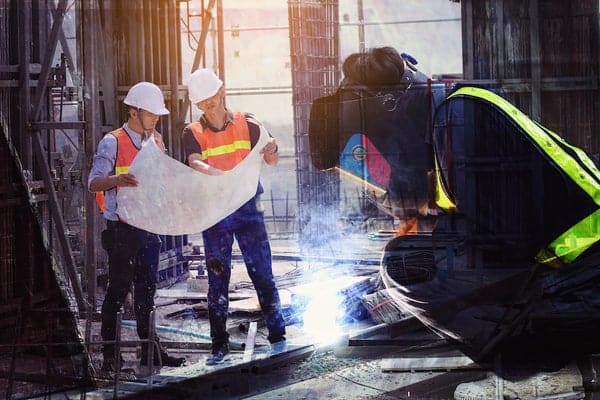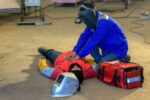When the environment for welding is in question, the environment should be dry. Even OSHA mentions that welding is safer when carried out in dry conditions.
So, does that mean you cannot weld on a wet floor? Well, the answer to this question is, yes, you can weld when it’s raining. But the more important question is should you weld on a wet floor rather than can you weld on a wet floor!
Although you can weld when the conditions are wet, you should refrain from doing so. The very fact that electricity is involved in welding and the human body can be the source of completing the circuit, welding in wet conditions increases the chances of being electrocuted without the right PPE.
The fact that welding in the rain is dangerous certainly raises a lot of eyebrows since underwater welding is a reality. However, you should know that equipment for underwater diving is very different from the ones used to weld on land.
Besides, underwater welders have to wear different PPE. Yet, there’s always the risk of musculoskeletal disorders and cognitive damage in underwater diving.
If you have no option but to weld in wet conditions, then there are certain precautions that you should follow without missing any. In the lapse of proper precautions, welders can even die from electrocution.
By the end of this guide, you’ll be able to make an informed decision whether or not you can (and should) weld on a wet floor. Without wasting any more time, let’s find out the truth.
Is it Legal to Weld in Wet Conditions?
According to OSHA, working in wet conditions is a bad choice a welder can make. However, sometimes, the work can be so demanding that there’s no option.
If you’re worried whether it’s legal to weld in the US while it’s pouring, the answer is an astonishing yes.
A hazard? Indeed! Illegal? Absolutely not. Welders working on a construction project have to take this tricky call whether or not they would work while it’s raining.
Choosing not to work in the rain can, at times, mean losing the job. However, it doesn’t mean you are forced to risk your life.
OSHA might not be restricting welding during a downpour, but it makes certain that the employers are responsible to provide their staff with the right (ASTM-approved) PPE for protection from the hazards of welding in wet conditions.
Is Welding on a Wet Floor Dangerous?
Dangerous does not even define the risk of welding on a wet floor since it can even mean death from electrocution.
So, yes, welding on a wet floor is dangerous. However, it doesn’t mean that you cannot weld when there’s a storm coming. With the right kind of welding machine and the right PPE equipment, you can protect yourself.
5 Ways to Make Sure You Aren’t Electrocuted When Working In Wet Conditions
There’s no denying that working on a wet floor is dangerous. At the same time, if you follow the safety rules, you’ll be able to work well and protect yourself from electric shocks.
We have compiled a list of 5 ways that will protect you when you’re welding in the rain. Have a look!
#1. Cover Yourself and Your Welding Arc
Your coveralls will protect you, but there’s no harm in protecting yourself further. If you’re welding outside and the weather is overcast or the rain has already begun, wear a good quality raincoat.
Bear in mind, the more you keep yourself dry, the safer you will be.
Also, cover your welding arc as well. It’s a no-brainer that a wet welding machine is just as risky as wet PPE.
#2 Cover Yourself From Top to Bottom
There are many pieces of equipment that are mandatory to protect you from electric hazards when you’re welding. Don’t skip even a single one. It’s better to look odd than being electrocuted.
Here’s the entire list:
→ EH-rated boots with rubber soles. They should be waterproof as well.
→ ASTM-approved waterproof gloves (note: waterproof, not water-resistant).
→ Work clothes that include full-length leather jeans or cotton jeans and full-length shirts.
→ Waterproof PPE overalls on top of your welding jeans and shirt.
→ Face mask and face shield.
In short, no part of your body should be left open to get wet.
#3 Protect Yourself From Perspiration
It’s not just the rain that can play a part in electrocuting you, sweat can also be the culprit. That’s why your jeans, boots, as well as gloves, should be moisture-wicking and breathable.
Whether it’s the rain that’s making you wet or sweat, it’s the wetness that’s your enemy. Protect yourself from getting wet: that’s the rule of welding in general and otherwise!
Bear in mind, sweat does the same thing that rain does. Even if it’s not raining and you’re sweating a lot, you can be electrocuted. That’s why there are EH-rated gloves and boots.
They are breathable, offer protection from all sorts of electrical hazards, and, most importantly, they will keep you dry.
#4. Use the Right Welding Machine
If there’s a lot of wind accompanying the thunderstorm, using a welding arc that uses gas is one of the biggest mistakes! The gas will blow away. Besides, it takes a lot of heat (way higher than the boiling point) for the arc to weld flawlessly.
Using the right welding machine is, therefore, the key to welding in the wind. The arc that doesn’t use gas and is easy to hold is the better option.
#5. Use a Rubber Mat
Instead of standing on soaking ground while handling a welding machine, stand on a high-quality rubber mat. Rubber doesn’t conduct electricity. It’s wonderful protection for welders.
Use the rubber mat to keep the welding machine on top of it. What’s even better is if you can use some sort of make-shift protection roof so that the machine doesn’t get wet either.
See also: Should You Use an Electric Welder Out in the Rain?
Can You Weld Wet Metal?
Now that we’ve addressed the dangers of welding in wet conditions and the ways that will definitely protect you from any harm, you might be wondering if it’s even possible to weld wet metal? And the answer to this question is YES.
Since underwater welding is real, welding wet metal is very much possible. However, there are certain things that you should know if you’re planning to weld wet metal.
Here’s the list:
-
-
- Welding wet metal can reduce efficiency.
- The welding can show bends and the work won’t look like the work of a professional.
- The metal can also break while welding if it’s wet.
-
If you don’t want to go through any of the problems mentioned above, make sure the welding arc is hot and running at its maximum capacity before you start to weld wet metal.
A hot welding arc is hotter than the boiling point. Once that temperature is attained, wet metal can be welded like a dream.
Concluding Thoughts:
You can weld on a wet floor and while it’s raining. However, it brings along the threat of getting electrocuted. That’s why you should be aware of how to weld on a wet floor.
Following all the precautions will at least eliminate the risk of getting electrocuted. Besides, it’s not illegal to weld on wet floors and wet conditions. It’s dangerous!
Only if you’re an experienced welder, you’ll be able to achieve perfection while welding wet metal. Experience, though, does not eliminate the fact that you should wear PPE and not take any chances.
Bear in mind, do have somebody close-by while welding in the rain so that help is at arm’s length in case anything happens and you require help.
We hope that you have all the information that you require about welding on a wet floor – its dangers and how to protect yourself from those dangers – and can make an informed decision now.







